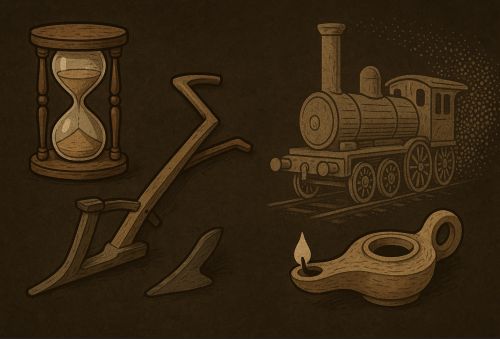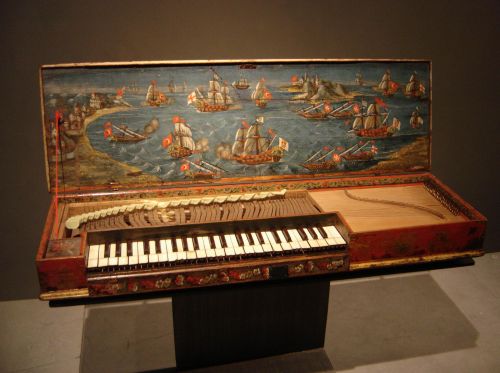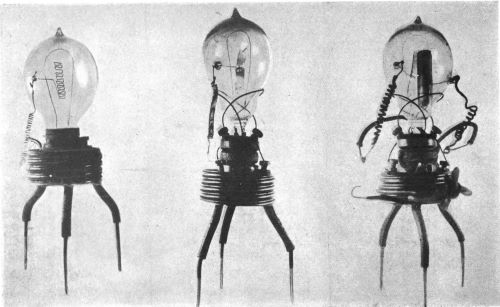

The disappearance of technologies across history reminds us that invention is not a steady ascent but a fragile chain, prone to rupture.

By Matthew A. McIntosh
Public Historian
Brewminate
Introduction
The common narrative of technological history privileges continuity — the great inventions that have endured, evolving through adaptation to shape human society. Yet an equally significant, though less examined, trajectory is that of technologies that have disappeared. Some were rendered obsolete by superior innovations, others lost through political collapse, secrecy, or cultural change. Their endings illuminate the fragility of knowledge and the contingency of progress. From Egyptian obelisks to supersonic passenger jets, the story of vanished technologies reveals that the trajectory of invention is neither linear nor inevitable, but often broken, forgotten, and rediscovered.
Ancient World
Egyptian Obelisk Quarrying

Few monuments capture the imagination like the towering obelisks of ancient Egypt, monoliths weighing hundreds of tons quarried, transported, and raised with precision that has long baffled modern engineers.1 The techniques, involving careful splitting of granite at Aswan, the use of dolerite pounders, and massive sledging, were once the pride of the pharaonic state. After the decline of monumental construction in the Late Period, however, the specialized knowledge and labor infrastructure required for such feats collapsed. Later civilizations admired these monuments, even transporting them to Rome, but they lacked the ability to replicate their production until the advent of modern cranes.2 What was once a symbol of divine kingship thus became an artifact of mystery.
Roman Concrete (Opus Caementicium)
Roman concrete underpinned aqueducts, harbors, and amphitheaters that still stand after two millennia.3 Unlike later European mortars, Roman opus caementicium incorporated volcanic ash that created chemical reactions strengthening structures over time. After the empire’s fragmentation, however, the formula and building methods fell into disuse in the West. Medieval builders returned to lime mortars, less durable and versatile. Only in the nineteenth century did scientific analysis begin to recover the secrets of Roman concrete, with twenty-first-century studies revealing its remarkable self-healing properties.4 The loss and rediscovery of this material exemplify how collapse can erase even practical knowledge central to daily life.
Greek Fire
The Byzantine weapon known as Greek fire, introduced in the seventh century, altered the balance of naval warfare.5 Capable of igniting upon water and devastating enemy fleets, it became legendary. The formula and the mechanics of its deployment were closely guarded by imperial artisans. So successful was this secrecy that, by the thirteenth century, both the recipe and delivery systems had vanished. Unlike Roman concrete, Greek fire has never been fully reconstructed.6 Its disappearance illustrates how technological monopolies can secure power for a time but often at the cost of eventual extinction.
Medieval and Early Modern
Damascus Steel

Few materials achieved such mythical renown as Damascus steel. Produced from “wootz” ingots imported from India, the blades forged in the Near East combined strength, flexibility, and a distinctive watery pattern.7 By the seventeenth century, however, the global supply of wootz dwindled, and by the eighteenth century the tradition of production had largely vanished. Despite modern metallurgical advances, the exact techniques, involving trace elements and crucible processes, remain elusive.8 What was once the pinnacle of weapons technology became a lost art, leaving only relics and legends.
Viking Sunstone Navigation
Norse sagas describe navigators using mysterious “sunstones” to locate the sun through clouds or twilight. Recent archaeological and experimental evidence suggests these were likely calcite or cordierite crystals capable of polarizing light.9 While effective, the practice appears to have faded with the decline of Viking long-distance voyages. Later European sailors relied instead on the magnetic compass, which by the thirteenth century had spread from China.10 Here, obsolescence, rather than secrecy or collapse, extinguished the technique.
Medieval Siege Engines
The great trebuchets and torsion engines of medieval warfare embodied both engineering ingenuity and political might.11 Yet by the fifteenth century, the arrival of gunpowder artillery rendered them obsolete. Cannon fire, though initially unreliable, quickly surpassed the destructive power of mechanical siege engines, and by the early modern era trebuchets survived only in chronicles and memory.12 The shift demonstrates how new military technologies often annihilate their predecessors, leaving them to vanish with startling rapidity.
Industrial and Early Modern
Clavichord

The clavichord, prized in Renaissance and Baroque Europe for its delicate, expressive sound, epitomized intimacy in music-making.13 Its quiet tones suited private chambers but not large concert halls. With the rise of the harpsichord and, more decisively, the piano, the clavichord slipped into obsolescence by the late eighteenth century. Though revived by early music enthusiasts in the twentieth century, it remains a relic of a bygone domestic culture.14
Stagecoach Systems
In the centuries before railroads, stagecoach systems linked towns and cities across Europe and America. Routes required networks of inns, post houses, and horse relays, forming an infrastructure of mobility.15 Yet within a few decades of the steam locomotive’s spread in the nineteenth century, stagecoaches disappeared almost entirely. Their obsolescence exemplifies how quickly entire logistical ecosystems can collapse when displaced by more efficient technologies.
Luddite-Era Looms
The industrial revolution not only birthed new machinery but rendered earlier devices extinct. Hand-operated looms and spinning wheels gave way to mechanized frames housed in factories.16 The destruction of such machines by Luddites in the early nineteenth century was both a protest against displacement and a recognition that older methods were dying. By mid-century, many of these technologies survived only in rural households, their industrial role permanently ended.
Modern and Contemporary
Vacuum Tube Electronics

For much of the early twentieth century, vacuum tubes powered radios, telephones, and the first computers.17 The invention of the transistor in 1947 quickly rendered them obsolete. Smaller, cheaper, and far more reliable, transistors transformed electronics, while vacuum tubes became confined to niche uses in audio amplification. Their end marked a decisive break in the history of computation and communication.
Concorde Supersonic Flight
The Concorde, introduced in 1976, embodied the dream of supersonic passenger travel.18 Yet its high costs, noise restrictions, limited range, and the crash of 2000 undermined its viability. By 2003, the program was retired, and with it the promise of routine supersonic commercial flight. Despite renewed interest, no successor has yet restored what Concorde once represented, a rare instance where technology advanced and then receded.
Polaroid Instant Film (First Iteration)
Polaroid cameras transformed personal photography in the mid-twentieth century. Yet the rise of digital cameras in the late 1990s and early 2000s drove the company into bankruptcy, and production of instant film ceased.19 Though later revived by enthusiasts, the original technology effectively ended as a mainstream practice. Its demise reflects how digital revolutions can erase analog formats almost overnight.
Space Shuttle Program
The U.S. Space Shuttle program, inaugurated in 1981, promised a reusable future for spaceflight.20 After the Challenger and Columbia disasters, mounting costs, and design limitations, the fleet was retired in 2011. Today’s space programs look instead to new rockets and capsules, leaving the shuttle as a historical dead end. Its ending underscores the fact that even advanced technologies may prove transitional, abandoned for more practical alternatives.
Conclusion
The disappearance of technologies across history reminds us that invention is not a steady ascent but a fragile chain, prone to rupture. Some vanish through collapse, like Roman concrete; others through obsolescence, like stagecoaches; others through secrecy, like Greek fire. Even in modern times, from Concorde to the Space Shuttle, celebrated breakthroughs can come to abrupt ends. To study these vanished technologies is to recognize that the history of knowledge is defined as much by forgetting as by remembering.
Appendix
Footnotes
- Dieter Arnold, Building in Egypt: Pharaonic Stone Masonry (Oxford: Oxford University Press, 1991), 211–215.
- John Baines and Jaromir Malek, Atlas of Ancient Egypt (New York: Facts on File, 1980), 84–86.
- David Moore, The Roman Pantheon: The Triumph of Concrete (Cambridge: Cambridge University Press, 1995), 32–37.
- Marie Jackson et al., “Mechanical Resilience Cementitous Processes in Imperial Roman Architectural Morar,” Proceedings of the National Academy of Sciences of the United States of America 111, no. 52 (2014): 18484-18489.
- John Haldon, The Byzantine Wars (Stroud: Tempus, 2001), 118–121.
- James Partington, A History of Greek Fire and Gunpowder (Baltimore: Johns Hopkins University Press, 1998), 19–23.
- Verhoeven, J.D., A.H. Pendray, and W.E. Dauksch, “The Key Role of Impurities in Ancient Damascus Steel Blades,” JOM 50, no. 9 (1998): 58–64.
- R. Balasubramaniam, The Wootz Steel: An Advanced Material of the Ancient World (Kanpur: Indian Institute of Technology, 2002), 41–47.
- Guy Ropars et al., “A Depolarizer as a Possible Viking Navigational Tool,” Proceedings of the Royal Society A 466 (2010): 875–890.
- Joseph Needham, Science and Civilisation in China, vol. 4 (Cambridge: Cambridge University Press, 1971), 249–252.
- Donald Hill, A History of Engineering in Classical and Medieval Times (London: Croom Helm, 1984), 167–171.
- Geoffrey Parker, The Military Revolution: Military Innovation and the Rise of the West (Cambridge: Cambridge University Press, 1996), 32–35.
- Raymond Russell, The Harpsichord and Clavichord: An Introductory Study, Pittsburgh: October House, 1965.
- David Schulenberg, The Keyboard Music of J.S. Bach (London: Routledge, 2006), 12–15.
- Charles G. Harper, Stagecoach and Mail in Days of Yore (London: Chapman & Hall, Limited, 1903), 53–59.
- Eric Hobsbawm, Industry and Empire: From 1750 to the Present Day (London: Penguin, 1968), 115–118.
- Paul Horowitz and Winfield Hill, The Art of Electronics (Cambridge: Cambridge University Press, 2015), 9–11.
- Kenneth Owen, Concorde: Story of a Supersonic Pioneer (London: Science Museum, 2001), 133–137.
- Christopher Bonanos, Instant: The Story of Polaroid (New York: Princeton Architectural Press, 2012), 188–190.
- Roger Launius, Space Shuttle Legacy: How We Did It and What We Learned (Washington, DC: NASA, 2013), 3–9.
Bibliography
- Arnold, Dieter. Building in Egypt: Pharaonic Stone Masonry. Oxford: Oxford University Press, 1991.
- Baines, John, and Jaromir Malek. Atlas of Ancient Egypt. New York: Facts on File, 1980.
- Balasubramaniam, R. The Wootz Steel: An Advanced Material of the Ancient World. Kanpur: Indian Institute of Technology, 2002.
- Bonanos, Christopher. Instant: The Story of Polaroid. New York: Princeton Architectural Press, 2012.
- Haldon, John. The Byzantine Wars. Stroud: Tempus, 2001.
- Harper, Charles G. Stagecoach and Mail in Days of Yore. London: Chapman & Hall, LImited, 1903.
- Hill, Donald. A History of Engineering in Classical and Medieval Times. London: Croom Helm, 1984.
- Hobsbawm, Eric. Industry and Empire: From 1750 to the Present Day. London: Penguin, 1969.
- Horowitz, Paul, and Winfield Hill. The Art of Electronics. Cambridge: Cambridge University Press, 2015.
- Jackson, Marie, et al. “Mechanical Resilience Cementitous Processes in Imperial Roman Architectural Morar.” Proceedings of the National Academy of Sciences of the United States of America 111, no. 52 (2014): 18484-18489.
- Launius, Roger. Space Shuttle Legacy: How We Did It and What We Learned. Washington, DC: NASA, 2013.
- Moore, David. The Roman Pantheon: The Triumph of Concrete. Cambridge: Cambridge University Press, 1995.
- Needham, Joseph. Science and Civilisation in China. Vol. 4. Cambridge: Cambridge University Press, 1971.
- Owen, Kenneth. Concorde: Story of a Supersonic Pioneer. London: Science Museum, 2001.
- Parker, Geoffrey. The Military Revolution: Military Innovation and the Rise of the West. Cambridge: Cambridge University Press, 1996.
- Partington, James. A History of Greek Fire and Gunpowder. Baltimore: Johns Hopkins University Press, 1998.
- Ropars, Guy, et al. “A Depolarizer as a Possible Viking Navigational Tool.” Proceedings of the Royal Society A 466 (2010): 875–890.
- Schulenberg, David. The Keyboard Music of J.S. Bach. London: Routledge, 2006.
- Russell, Raymond. The Harpsichord and Clavichord: An Introductory Study. Pittsburgh: October House, 1965.
- Verhoeven, J.D., A.H. Pendray, and W.E. Dauksch. “The Key Role of Impurities in Ancient Damascus Steel Blades.” JOM 50, no. 9 (1998): 58–64.
Originally published by Brewminate, 08.22.2025, under the terms of a Creative Commons Attribution-NonCommercial-NoDerivatives 4.0 International license.


